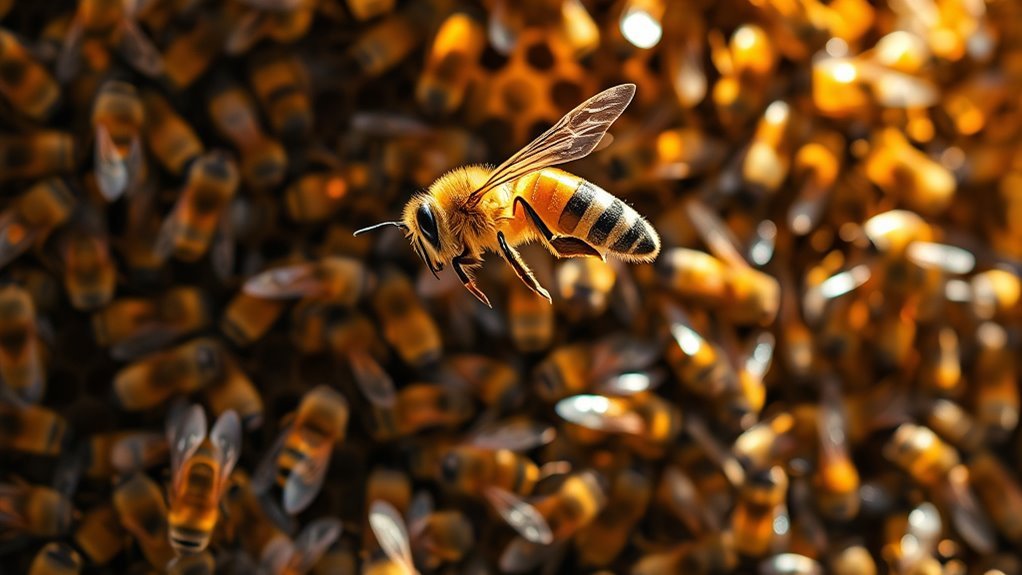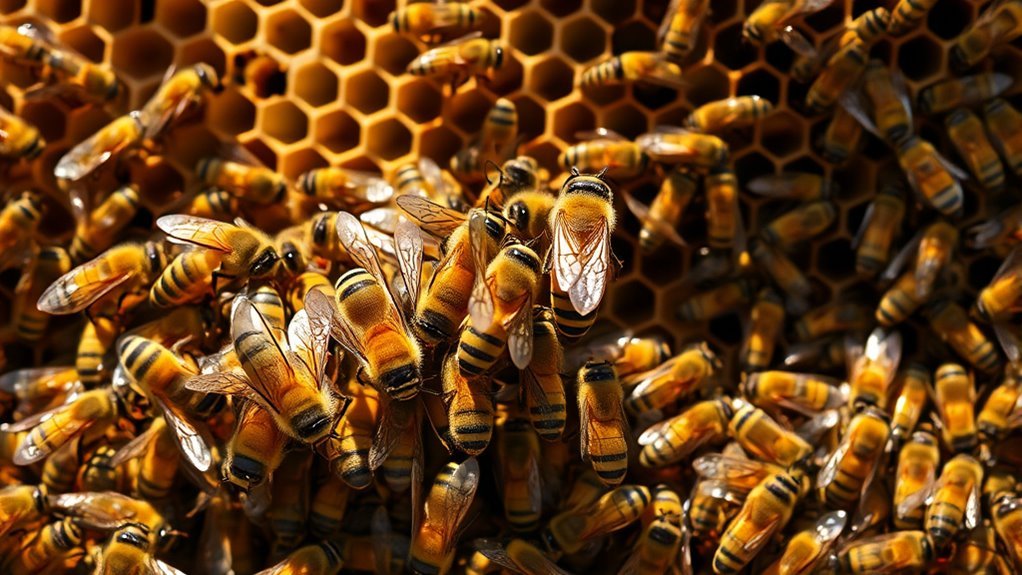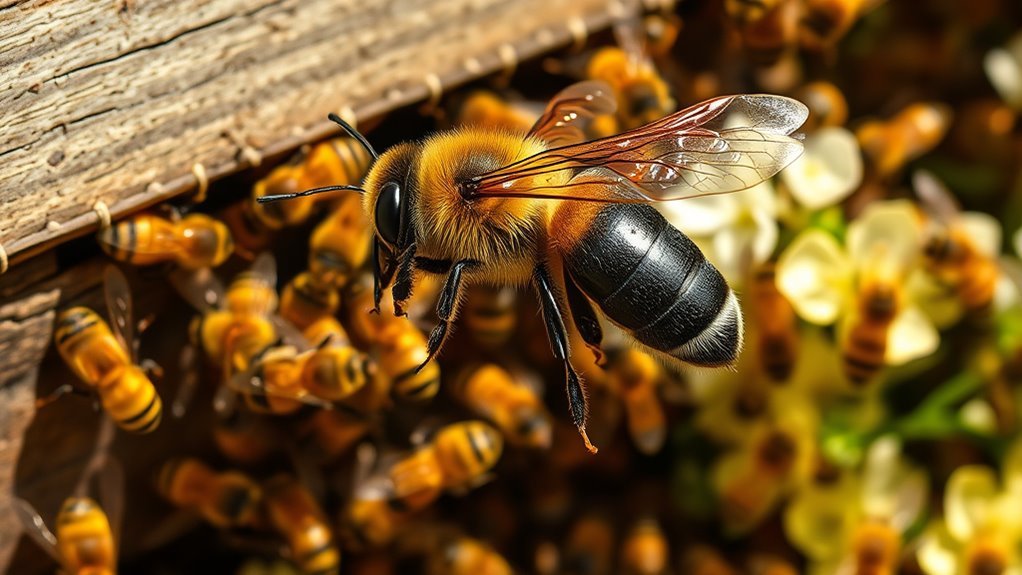You’ll find that drones in a bee colony primarily serve to mate with virgin queens, ensuring genetic diversity essential for colony resilience. They don’t forage or maintain the hive but have specialized physical traits for locating queens during flight. Developing from unfertilized eggs, their numbers and health directly impact reproductive success and colony stability. Seasonal changes influence their population and behavior, balancing mating opportunities with resource demands. Exploring further reveals how these roles intertwine with hive dynamics and health.
Overview of Drone Bees

Drone bees play a specialized role within a honeybee colony, primarily tasked with mating with a queen from another hive to secure genetic diversity. When you observe drone behaviors, you’ll notice they don’t participate in typical worker tasks like foraging or hive maintenance. Instead, their primary focus centers on mating rituals conducted during specific flight periods called nuptial flights. During these flights, drones congregate in drone congregation areas, waiting for virgin queens to appear. Their mating behavior is precise and brief, involving aerial coupling that ends with the drone’s death. Understanding these behaviors highlights the drone’s singular biological imperative—successful reproduction. By fulfilling this role, drones support the colony’s genetic variation, promoting resilience and adaptability, which aligns with your appreciation for natural freedom and the evolutionary benefits it provides.
Physical Characteristics of Drones

While their role centers on reproduction, the physical structure of these male bees is uniquely adapted to support their specific functions within the colony. When you examine drone anatomy, you’ll notice they are larger than worker bees, with more robust bodies and bigger eyes. These large eyes provide enhanced vision, essential for locating queens during flight. Unlike workers, drones lack stingers and pollen-collecting structures, reflecting their specialized reproductive role. Their wings are proportioned to facilitate strong, sustained flight, matching the demands of mating flights. Additionally, drones have a shorter drone lifespan, typically living only a few weeks, as their primary purpose is mating during a limited season. Understanding these physical traits clarifies how drones contribute uniquely and efficiently to the colony’s reproductive success.
The Role of Drones in Mating

Because their primary function is reproduction, male bees play an essential role in the colony’s genetic continuation by participating in mating flights. During these flights, drones leave the hive to locate and mate with virgin queens from different colonies, ensuring the spread of genetic material beyond their own hive. This behavior promotes genetic diversity, which is important for the resilience and adaptability of bee populations. As you observe, drones gather in specific aerial congregation areas, increasing the likelihood of successful mating encounters. After mating, drones typically die, emphasizing the one-time nature of their reproductive role. Understanding this process highlights how drones contribute directly to the evolutionary fitness of the colony, enabling you to appreciate their indispensable yet specialized function within the complex social structure of bees.
How Drones Develop in the Hive
You’ll observe that drones develop from unfertilized eggs laid by the queen in specialized larger cells. Their growth from egg to adult typically spans about 24 days, influenced by factors like temperature and nutrition within the hive. Understanding these environmental impacts helps clarify how hive conditions regulate drone population and health.
Drone Egg to Adult
Although drones share the hive environment with worker and queen bees, their development follows a distinct timeline and set of stages. Drone development begins when a queen lays an unfertilized egg in a larger drone cell; because of the lack of egg fertilization, drones are haploid, carrying only one set of chromosomes. The egg hatches after about three days, progressing into larval and pupal stages within approximately 24 days. During this period, worker bees feed and care for the developing drone, ensuring proper growth. Unlike workers, drones do not perform hive labor as they mature. By understanding this precise drone development cycle from egg to adult, you appreciate how the colony balances reproductive roles with its complex social structure.
Hive Environment Impact
Understanding drone development from egg to adult provides a foundation for examining how the hive environment influences this process. You’ll find that stable hive temperature is crucial; drones require a narrow thermal range to guarantee proper growth and metabolic function. Similarly, maintaining ideal humidity levels prevents desiccation or fungal growth in brood cells. Airflow dynamics within the hive regulate both temperature and humidity, facilitating gas exchange and waste removal, which supports healthy drone maturation. Resource allocation also plays an essential role—worker bees must balance feeding larvae with nectar and pollen to meet the energetic demands of drone development. Disruptions in any of these environmental factors can impair drone viability and, consequently, affect the colony’s reproductive potential. By appreciating these parameters, you understand how the hive environment intricately shapes drone growth.
Drones and Colony Genetics
When you examine the role of drones within a bee colony, their contribution to colony genetics becomes vital. Drone genetics directly influence the genetic diversity of the colony, which is important for its adaptability and resilience. Because drones are haploid, carrying only one set of chromosomes, their genetic material comes solely from the queen. This unique genetic input guarantees varied offspring when drones mate with queens from different colonies. Increased genetic diversity reduces susceptibility to diseases and environmental stressors, promoting a robust colony structure. By understanding drone genetics, you appreciate how drones function as vectors of genetic variation, sustaining the colony’s evolutionary fitness. Their role extends beyond reproduction; they are key to maintaining a healthy gene pool that supports freedom in colony adaptation and survival.
Seasonal Behavior of Drone Bees
The genetic role drones play in a colony sets the stage for their activity patterns throughout the year. You’ll notice drone behavior shifts distinctly with seasonal patterns, reflecting reproductive readiness and environmental conditions. During spring and summer, drones become more active, preparing for mating flights. In contrast, fall and winter see a decline in numbers as drones are expelled to conserve resources.
| Season | Drone Activity Level | Purpose |
|---|---|---|
| Spring | Increasing | Development and mating prep |
| Summer | Peak | Mating flights and reproduction |
| Fall/Winter | Decreasing | Reduced activity, colony ejection |
Understanding these patterns helps you appreciate how drones contribute within seasonal limits, balancing genetic dissemination with colony sustainability.
Interaction Between Drones and Worker Bees
Interactions between drones and worker bees are limited but vital for colony function. You’ll notice that drone behavior primarily revolves around reproduction, yet worker interaction plays an important role in sustaining drones. Workers regulate drone access to resources, such as food and hive maintenance, ensuring drones remain healthy for mating flights. While drones lack the ability to gather nectar or pollen, workers feed and groom them, reflecting a unidirectional dependency. Furthermore, worker bees manage drone presence during seasonal shifts, controlling their numbers to balance colony energy expenditure. These interactions, though minimal, maintain colony harmony and reproductive success. Understanding this dynamic lets you appreciate how drone behavior and worker interaction combine, supporting the colony’s reproductive goals without compromising its cooperative structure or resource allocation.
The Impact of Drones on Colony Health
Although drones don’t participate in foraging or hive maintenance, their presence greatly influences colony health through reproductive roles and resource demands. You must consider that drone health directly affects colony stability, as drones are crucial for queen fertilization and genetic diversity. However, drones consume significant resources, which can strain the colony if their numbers are excessive or if they carry pathogens. Maintaining an ideal drone population guarantees reproductive success without compromising hive robustness.
| Factor | Impact on Colony Health | Notes |
|---|---|---|
| Drone Health | Influences reproductive success | Crucial for queen fertilization |
| Resource Consumption | Affects resource allocation | Excess drones strain resources |
| Genetic Diversity | Enhances colony resilience | Supports adaptability |
| Pathogen Transmission | Risk of disease spread | Can destabilize colony health |
Factors Influencing Drone Population in a Hive
You’ll notice that drone populations vary considerably with seasonal changes, peaking during spring and summer when mating opportunities are highest. The availability of hive resources, such as nectar and pollen, directly affects how many drones the colony can support. Understanding these factors helps explain the dynamic nature of drone numbers within a hive.
Seasonal Drone Fluctuations
When environmental conditions shift throughout the year, the number of drones within a bee colony adjusts accordingly. You’ll notice drone scarcity outside the mating season, as colonies conserve resources. During mating season, drone populations surge to maximize reproductive success. Key factors influencing these fluctuations include:
- Temperature changes affecting drone development speed
- Availability of mating opportunities driving drone production
- Seasonal variations in daylight influencing colony behavior
- Colony’s strategic allocation of energy towards reproduction versus survival
Understanding these patterns helps you appreciate how colonies balance drone numbers with environmental demands. By adjusting drone populations seasonally, hives optimize mating chances while minimizing unnecessary energy expenditure. This dynamic regulation guarantees the colony maintains freedom to thrive across varying seasons without overcommitting resources to drones when conditions aren’t favorable.
Hive Resources Impact
Seasonal changes set the stage for drone population shifts, but the availability and allocation of hive resources play a significant role in determining how many drones a colony can support. Hive productivity directly influences resource allocation, impacting food storage and bee nutrition essential for sustaining drones. When forage availability is high, colonies experience improved hive efficiency, allowing greater investment in drones despite environmental stressors. However, during periods of scarcity, resource competition intensifies, forcing the colony to prioritize worker bees over drones to maintain colony dynamics. Seasonal resources fluctuate, and your hive’s ability to adapt resource distribution accordingly governs drone survival and reproduction rates. Understanding these factors helps you appreciate how hive resources dictate drone population, balancing reproductive success with the colony’s overall health and freedom to thrive.

